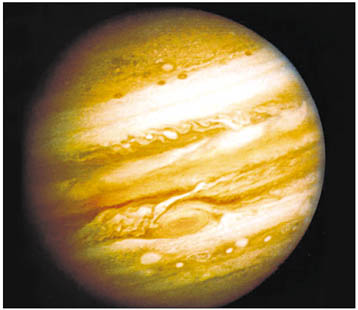
Latest Space Discoveries
, Pls keep adding
| Dimple |
 Aug 8 2007, 01:43 PM Aug 8 2007, 01:43 PM
Post
#1
|
|
Regular Member  Group: Members Posts: 585 Joined: 7-June 07 From: Bombay Member No.: 16381 |
Largest known planet discovered
-------------------------------------------------------------------------------- gas giant: The new planet — TrES-4 — is 70 per cent larger than Jupiter (left) Cape Canaveral (Florida): An international team of astronomers has discovered the largest known planet orbiting another star. The "transiting" planet — meaning one that passes in front of its parent star as seen from Earth — is about 70 per cent larger than Jupiter. But the presumed "gas giant" has a much lower mass than Jupiter — the biggest planet in our Solar System — making it of extremely low density. The new exoplanet, called TrES-4, is located in the constellation of Hercules and was discovered by a team working on the Transatlantic Exoplanet Survey (TrES). TrES-4 circles the star GSC02620-00648, which lies about 1,435 light-years away from Earth. Being only about 7 million km from its parent star, the planet is also very hot, about 1,327°C. Because of the relatively weak pull exerted by TrES-4 on its upper atmosphere, some of the atmosphere probably escapes in a curved comet-like tail. "TrES-4 is the largest known exoplanet," said lead author Georgi Mandushev, from the Lowell Observatory in Flagstaff, US. Surprising size It is so big, in fact, that its size is difficult to explain using current theories about superheated giant planets. "We continue to be surprised by how relatively large these giant planets can be," says Francis O'Donovan, a graduate student in astronomy at the California Institute of Technology which operates one of the TrES telescopes. — Agencies Attached image(s) 
"Shikwa nahin kisise, kisise gila nahin,
Naseeb mein nahin tha jo - humko mila nahin.."  |
  |
Replies
| Dimple |
 Sep 25 2007, 01:31 PM Sep 25 2007, 01:31 PM
Post
#2
|
|
Regular Member  Group: Members Posts: 585 Joined: 7-June 07 From: Bombay Member No.: 16381 |
NASA aims to put man on Mars by 2037
-------------------------------------------------------------------------------- new territory: NASA wants to build a civilisation on Mars Florida: NASA aims to put a man on Mars by 2037, the administrator of the US space agency indicated here yesterday. This year, 2007, marks the half-century of the space age ushered in by the 1957 launch of the Sputnik-1 by the then Soviet Union, NASA administrator Michael Griffin noted. In 2057, the centenary of the space era, "We should be celebrating 20 years of man on Mars," Griffin told an international astronautics congress. The international space station being built in orbit and targeted for completion by 2010 would provide a "toehold in space" from where humanity can travel first to the moon and then to Mars, Griffin said. "We are looking at the moon and Mars to build a civilisation for tomorrow," he added. NASA's Phoenix spacecraft is scheduled to land on the northern plains of Mars next year to determine if the Red Planet could support life. "Shikwa nahin kisise, kisise gila nahin,
Naseeb mein nahin tha jo - humko mila nahin.."  |
Posts in this topic
 Dimple Latest Space Discoveries Aug 8 2007, 01:43 PM
Dimple Latest Space Discoveries Aug 8 2007, 01:43 PM
 Dimple Distant space collision meant doom for dinosaurs
... Sep 6 2007, 04:12 PM
Dimple Distant space collision meant doom for dinosaurs
... Sep 6 2007, 04:12 PM
 Mandrake Dimple, your PM facility doesn't work, so I co... Sep 25 2007, 06:40 PM
Mandrake Dimple, your PM facility doesn't work, so I co... Sep 25 2007, 06:40 PM
 Dimple Thank YOU Mandrake :) You are one of the few who h... Sep 26 2007, 10:11 AM
Dimple Thank YOU Mandrake :) You are one of the few who h... Sep 26 2007, 10:11 AM
 Dimple Mandrake :) It is very good to read appreciation l... Sep 26 2007, 11:15 AM
Dimple Mandrake :) It is very good to read appreciation l... Sep 26 2007, 11:15 AM
 Mandrake The PM facility has been withdrawn for all the mem... Sep 30 2007, 08:26 PM
Mandrake The PM facility has been withdrawn for all the mem... Sep 30 2007, 08:26 PM
 Dimple Earth-like planet forming far away
AFP
Thursday, ... Oct 8 2007, 12:33 PM
Dimple Earth-like planet forming far away
AFP
Thursday, ... Oct 8 2007, 12:33 PM  |
1 User(s) are reading this topic (1 Guests and 0 Anonymous Users)
0 Members:

|
Lo-Fi Version | Disclaimer | HF Guidelines |  |
Time is now: 22nd June 2025 - 10:13 PM |
Invision Power Board
v2.1.7 © 2025 IPS, Inc.
Licensed to: Hamaraforums.com








